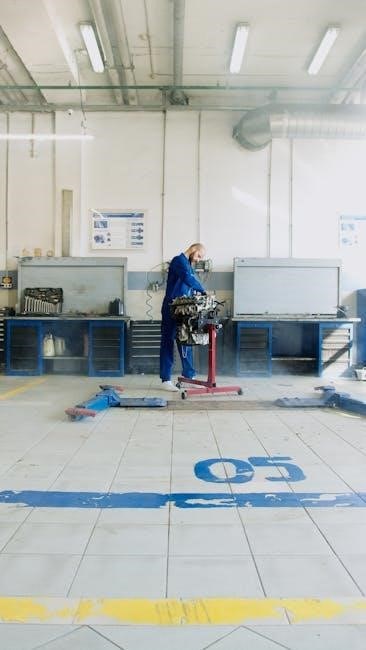Manual Transmission Service: A Comprehensive Guide
Manual transmissions‚ while robust‚ require regular service to ensure longevity and optimal performance. This guide provides essential information about maintaining your manual transmission.
Understanding Manual Transmissions
Manual transmissions‚ often favored for their simplicity and driver control‚ rely on a direct mechanical connection between the engine and wheels. Unlike automatic transmissions that use a torque converter and planetary gearsets‚ manual transmissions employ a clutch and a series of gears that the driver selects manually using a gear stick and clutch pedal. This design allows for greater driver engagement and‚ generally‚ better fuel efficiency compared to their automatic counterparts. The simplicity of the manual transmission also often translates to lower repair costs‚ although certain repairs‚ like clutch replacements‚ are common. Key components include the input shaft‚ output shaft‚ gears‚ synchronizers‚ shift forks‚ and the clutch assembly. The clutch disengages the engine from the transmission‚ allowing the driver to change gears smoothly. Synchronizers match the speeds of the gears before engagement‚ preventing grinding and ensuring smooth shifts. Regular maintenance‚ such as fluid checks and changes‚ is crucial to keep these components properly lubricated and functioning optimally. Understanding the basic mechanics of a manual transmission can help drivers recognize potential problems early on‚ preventing more extensive and costly repairs. Furthermore‚ knowing how to properly operate a manual transmission‚ including smooth clutch engagement and gear shifting‚ can significantly extend its lifespan.

Common Manual Transmission Problems
Manual transmissions‚ despite their robust design‚ can experience various issues; Recognizing these common problems early can prevent costly repairs and ensure smooth operation.
Clutch Issues
The clutch is a critical component in a manual transmission system‚ responsible for engaging and disengaging the engine from the drivetrain. Several issues can arise with the clutch‚ impacting its performance and requiring attention. Common clutch problems include:
- Clutch Slippage: This occurs when the clutch disc fails to fully engage with the flywheel‚ causing a loss of power transfer. Symptoms include a burning smell‚ difficulty accelerating‚ and the engine revving higher than usual without a corresponding increase in speed. Slippage can be caused by a worn clutch disc‚ oil contamination‚ or a faulty pressure plate.
- Clutch Drag: Conversely‚ clutch drag happens when the clutch disc doesn’t fully disengage from the flywheel‚ making it difficult to shift gears smoothly. This can result in grinding noises when shifting and difficulty getting the car into gear‚ especially first gear or reverse. Drag can be caused by a bent or damaged clutch disc‚ a worn pilot bearing‚ or a hydraulic system issue.
- Clutch Chatter: This is characterized by a vibration or shuddering sensation when engaging the clutch. Chatter can be caused by a variety of factors‚ including a warped flywheel‚ worn engine mounts‚ or contamination on the clutch disc.
- Hard or Stiff Clutch Pedal: A clutch pedal that requires excessive force to depress may indicate a problem with the clutch cable‚ hydraulic system‚ or pressure plate. A worn or damaged clutch cable can cause increased resistance‚ while a malfunctioning hydraulic system can reduce the force applied to the pressure plate.
- Clutch Noise: Unusual noises‚ such as squealing‚ grinding‚ or rattling‚ when the clutch pedal is depressed or released can indicate a problem with the throwout bearing‚ pilot bearing‚ or other clutch components.
Addressing clutch issues promptly is essential to prevent further damage to the transmission and ensure safe and reliable vehicle operation. Regular inspection and maintenance of the clutch system can help identify and resolve potential problems before they escalate.
Gear Slippage
Gear slippage in a manual transmission is a serious issue that can compromise vehicle safety and performance. It occurs when the transmission unexpectedly jumps out of gear while driving‚ often accompanied by a grinding noise or a sudden loss of power. Several factors can contribute to gear slippage‚ including:
- Worn or Damaged Gears: Over time‚ the gears within the transmission can wear down or become damaged due to normal use‚ improper shifting‚ or lack of lubrication. Worn gear teeth may not mesh properly‚ leading to slippage under load.
- Worn or Damaged Synchronizers: Synchronizers are responsible for matching the speed of the gears before they engage‚ ensuring smooth and quiet shifting. Worn or damaged synchronizers can make it difficult to engage gears properly‚ increasing the likelihood of slippage.
- Bent or Damaged Shift Forks: Shift forks are used to move the gears into and out of engagement. A bent or damaged shift fork may not fully engage the gear‚ causing it to slip out under load.
- Worn or Damaged Shift Linkage: The shift linkage connects the gear shift lever to the transmission. Worn or damaged linkage can create excessive play‚ resulting in imprecise shifting and potential gear slippage.
- Low or Contaminated Transmission Fluid: Transmission fluid lubricates the gears and synchronizers‚ reducing friction and wear. Low or contaminated fluid can reduce the effectiveness of these components‚ increasing the risk of slippage.
- Internal Transmission Damage: In some cases‚ gear slippage may be a symptom of more extensive internal transmission damage‚ such as broken bearings or a cracked case.
Addressing gear slippage promptly is crucial to prevent further damage to the transmission and ensure safe vehicle operation. Ignoring the problem can lead to more extensive and costly repairs down the road. If you experience gear slippage‚ it’s recommended to have your transmission inspected by a qualified mechanic as soon as possible.
Manual Transmission Service Intervals
Maintaining a consistent service schedule is crucial for the longevity and optimal performance of your manual transmission. Unlike automatic transmissions‚ manuals often require less frequent maintenance‚ but neglecting these intervals can lead to significant problems and costly repairs. The recommended service intervals can vary based on driving habits‚ vehicle manufacturer specifications‚ and the type of fluid used; However‚ here are some general guidelines to follow:
- Fluid Check: It’s advisable to check your manual transmission fluid level every 30‚000 to 60‚000 miles‚ or as specified in your vehicle’s owner’s manual. Low fluid levels can indicate a leak‚ which needs to be addressed promptly to prevent damage. The fluid should also be checked for contamination‚ such as a dark color or metallic particles‚ which can indicate internal wear.
- Fluid Replacement: The recommended interval for changing manual transmission fluid typically falls between 30‚000 and 60‚000 miles. However‚ if you engage in heavy-duty driving‚ such as towing or frequent stop-and-go traffic‚ you may need to change the fluid more frequently. Using the correct type of fluid‚ as specified by the vehicle manufacturer‚ is crucial for optimal performance and protection.
- Clutch Adjustment: The clutch may require adjustment periodically to maintain proper engagement and disengagement. The frequency of adjustment depends on driving habits and clutch wear. Signs that your clutch needs adjustment include difficulty shifting gears or a clutch pedal that feels loose or spongy.
- Inspection: A thorough inspection of the manual transmission should be performed every 60‚000 miles or as part of a major service. This inspection should include checking for leaks‚ inspecting the shift linkage for wear or damage‚ and evaluating the overall condition of the transmission.
By adhering to these service intervals‚ you can help prevent costly repairs and ensure that your manual transmission continues to provide reliable performance for years to come. Always consult your vehicle’s owner’s manual for the manufacturer’s specific recommendations.

Essential Manual Transmission Service Procedures
Servicing a manual transmission involves several key procedures to ensure its proper function and longevity. These procedures include fluid checks‚ fluid replacement‚ and clutch adjustments.
Fluid Check and Replacement
Maintaining the correct fluid level and condition is crucial for a manual transmission’s health. Transmission fluid lubricates the gears‚ bearings‚ and other internal components‚ preventing wear and tear. Regular fluid checks can identify leaks or contamination‚ preventing costly repairs down the line. A simple leak repair may cost only a few hundred dollars‚ making regular checks worthwhile.
Checking the fluid level typically involves locating the fill plug on the transmission case. Consult your vehicle’s service manual for the exact location and procedure. The fluid should be at the specified level‚ usually just below the fill plug opening. If the fluid is low‚ add the recommended type of transmission fluid until it reaches the correct level.
Fluid replacement is also essential. Over time‚ transmission fluid degrades‚ losing its lubricating properties and accumulating contaminants. The frequency of fluid replacement depends on driving conditions and the manufacturer’s recommendations‚ but it’s generally recommended every 30‚000 to 60‚000 miles. Replacing the fluid involves draining the old fluid and refilling with new fluid. Some mechanics may need to completely dismantle the transmission for inspection‚ which can affect the repair cost.
When replacing the fluid‚ it’s crucial to use the correct type of fluid specified for your vehicle. Using the wrong fluid can damage the transmission. Refer to your vehicle’s service manual or consult with a qualified mechanic to determine the appropriate fluid. Consider that regular maintenance‚ such as fluid checks and scheduled servicing‚ can help prevent expensive transmission repairs.
Clutch Adjustment
Proper clutch adjustment is vital for smooth shifting and preventing premature wear of the clutch components. The clutch is responsible for disengaging the engine from the transmission‚ allowing you to shift gears. Over time‚ the clutch linkage can become misaligned‚ leading to difficult shifting‚ clutch slippage‚ or a dragging clutch.
Clutch adjustment involves ensuring the correct amount of free play in the clutch pedal. Free play is the distance the pedal travels before the clutch begins to disengage. Too much free play can result in incomplete clutch disengagement‚ making shifting difficult. Too little free play can cause the clutch to slip‚ leading to accelerated wear. Consult your vehicle’s service manual for the specific free play specifications for your vehicle.
The adjustment procedure varies depending on the vehicle. Some vehicles have a mechanical linkage that can be adjusted using a threaded rod or cable. Other vehicles have a hydraulic clutch system that may require bleeding the system to remove air bubbles. In some cars‚ the clutch is mostly mechanical gears that rely on the driver to engage the clutch and shift when needed;
If you’re not comfortable performing the adjustment yourself‚ it’s best to take your vehicle to a qualified mechanic. They have the expertise and tools to properly adjust the clutch and ensure it’s functioning correctly. Clutch replacements‚ a common manual transmission repair‚ usually cost between $500 and $1‚500‚ so proper adjustment can extend the life of your clutch.

Cost of Manual Transmission Service and Repair
Understanding the potential costs associated with manual transmission service and repair is crucial for budgeting and making informed decisions about your vehicle’s maintenance.
Factors Affecting the Cost
The cost of manual transmission service and repair can fluctuate significantly based on several key factors. Understanding these elements can help you anticipate expenses and make informed decisions.
- Type of Repair: Minor repairs like fluid leaks or clutch adjustments will naturally be less expensive than major overhauls or complete transmission replacements. The extent of damage dictates the labor and parts required‚ directly impacting the overall cost.
- Parts Availability & Source: Opting for Original Equipment Manufacturer (OEM) parts from the auto manufacturer generally results in higher costs compared to aftermarket or used parts. Older or rarer car models often have limited parts availability‚ further increasing expenses. Sourcing parts from junkyards can be a cost-effective solution‚ but requires careful inspection for quality.
- Labor Costs: Dealerships typically have higher labor rates than independent auto shops. The complexity of the repair and the mechanic’s hourly rate contribute significantly to the total cost. Some shops charge a flat rate for transmission replacement‚ while others bill hourly.
- Vehicle Make and Model: High-performance or luxury vehicles tend to have more expensive parts and require specialized expertise‚ leading to higher repair costs. The specific design and complexity of the transmission in your vehicle also play a role.
- Location: Average transmission repair and replacement prices can vary depending on your geographical location due to differences in labor rates and parts availability.
- New vs. Rebuilt vs. Used Transmission: Choosing a new transmission is the most expensive option‚ while rebuilt or remanufactured transmissions offer a cost-effective alternative. Used transmissions are the cheapest‚ but carry the highest risk of future problems.
Average Repair Costs
Determining average repair costs for manual transmissions can provide a helpful benchmark‚ but keep in mind that actual prices will vary based on the factors previously mentioned. These figures are estimates and should be used as a general guideline only.
- Clutch Replacement: A common repair for manual transmissions‚ clutch replacements typically range from $500 to $1‚500‚ including parts and labor. This cost can vary depending on the clutch kit used and the complexity of the vehicle’s design.
- Transmission Fluid Change/Flush: A relatively inexpensive maintenance task‚ a transmission fluid change or flush usually costs between $100 and $200. Regular fluid changes help prevent more serious and costly problems.
- Minor Repairs (Leaks‚ Adjustments): Small repairs like fixing fluid leaks or adjusting the clutch linkage can range from $300 to $600‚ depending on the specific issue and the mechanic’s labor rate.
- Transmission Repair (Internal Components): Repairing internal transmission components‚ such as gears or bearings‚ can range from $500 to $2‚500‚ depending on the extent of the damage and the parts that need to be replaced.
- Transmission Replacement: Replacing a manual transmission is a more significant expense‚ typically ranging from $1‚500 to $3‚000 for non-luxury vehicles. This cost includes the transmission itself and the labor to install it. Rebuilt or remanufactured transmissions can be a more affordable alternative.
- Transmission Rebuild: Rebuilding a transmission involves disassembling it‚ replacing worn or damaged parts‚ and reassembling it. This can cost between $1‚100 and $3‚200‚ depending on the car model and the extent of the damage.
It’s always recommended to get a detailed estimate from a reputable mechanic before authorizing any manual transmission service or repair.

DIY vs. Professional Manual Transmission Service
Extending the Life of Your Manual Transmission
A manual transmission‚ though generally robust‚ benefits significantly from proactive maintenance and careful driving habits. By implementing a few key strategies‚ you can significantly extend the lifespan of your manual transmission‚ minimizing the need for costly repairs and replacements. Here are some essential tips:
- Regular Fluid Checks and Changes: Transmission fluid is the lifeblood of your manual transmission‚ lubricating its internal components and dissipating heat. Regularly check the fluid level and condition‚ and adhere to the manufacturer’s recommended fluid change intervals. Using the correct type of transmission fluid is crucial for optimal performance and longevity.
- Proper Shifting Techniques: Avoid harsh or abrupt shifting‚ which can put undue stress on the transmission’s gears and synchronizers. Practice smooth and deliberate shifting‚ ensuring the clutch is fully engaged and disengaged during each gear change.
- Avoid Riding the Clutch: “Riding the clutch” (partially engaging the clutch pedal while driving) causes excessive wear on the clutch disc. Keep your foot off the clutch pedal unless you’re actively shifting gears.
- Proper Towing Practices: If you frequently tow trailers or heavy loads‚ ensure your vehicle is properly equipped for towing and follow the manufacturer’s recommendations for towing capacity. Heavy towing can put significant strain on the transmission.
- Address Problems Promptly: If you notice any unusual noises‚ shifting difficulties‚ or other signs of transmission trouble‚ address the problem promptly. Ignoring minor issues can lead to more serious and expensive repairs down the road.
- Avoid Aggressive Driving: Excessive acceleration‚ hard braking‚ and other forms of aggressive driving can accelerate wear and tear on the transmission. Drive smoothly and conservatively to minimize stress on the components.
By following these simple tips‚ you can help ensure that your manual transmission provides reliable service for many years to come.